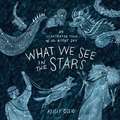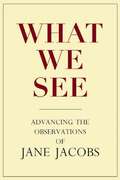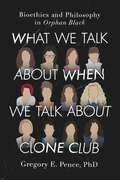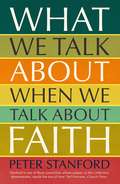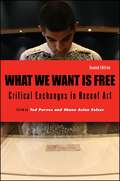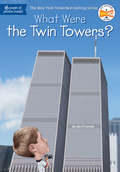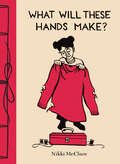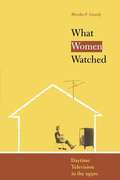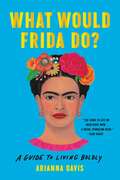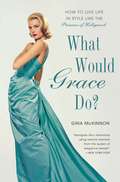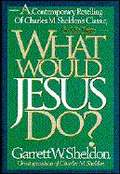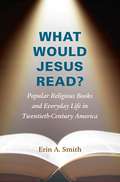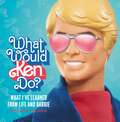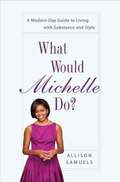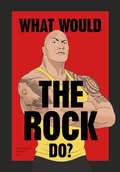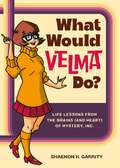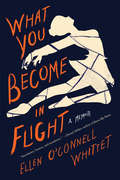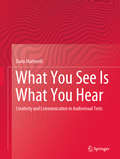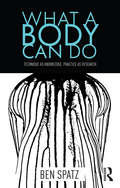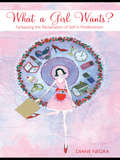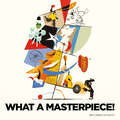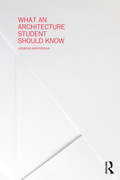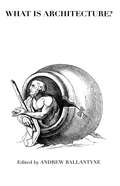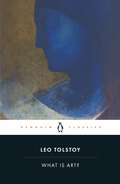- Table View
- List View
What We See in the Stars: An Illustrated Tour of the Night Sky
by Kelsey OseidA richly illustrated guide to the myths, histories, and science of the celestial bodies of our solar system, with stories and information about constellations, planets, comets, the northern lights, and more. Combining art, mythology, and science, What We See in the Stars gives readers a tour of the night sky through more than 100 magical pieces of original art, all accompanied by text that weaves related legends and lore with scientific facts. This beautifully packaged book covers the night sky's most brilliant features--such as the constellations, the moon, the bright stars, and the visible planets--as well as less familiar celestial phenomena like the outer planets, nebulae, and deep space. Adults seeking to recapture the magic of youthful stargazing, younger readers interested in learning about natural history and outer space, and those who appreciate beautiful, hand-painted art will all delight in this charming book.
What We See: Advancing the Observations of Jane Jacobs
by Edited by Stephen A. Goldsmith and Lynne ElizabethA timely revisitation of renowned urbanist-activist Jane Jacobs' lifework, What We See invites thirty pundits and practitioners across fields to refresh Jacobs' economic, social and urban planning theories for the present day. Combining personal and professional observations with meditations on Jacobs' insights, essayists bring their diverse experience to bear to sketch the blueprints for the living city.The book models itself after Jacobs' collaborative approach to city and community building, asking community members and niche specialists to share their knowledge with a broader community, to work together toward a common goal of building the 21st-century city.The resulting collection of original essays expounds and expands Jacobs' ideas on the qualities of a vibrant, robust urban area. It offers the generalist, the activist, and the urban planner practical examples of the benefits of planning that encourages community participation, pedestrianism, diversity, environmental responsibility, and self-sufficiency.Bob Sirman, director of the Canada Council for the Arts, describes how built form should be an embodiment of a community narrative. Daniel Kemmis, former Mayor of Missoula, shares an imagined dialog with Jacobs, discussing the delicate interconnection between cities and their surrounding rural areas. And Roberta Brandes Gratz?urban critic, author, and former head of Public Policy of the New York State Preservation League?asserts the importance of architectural preservation to environmentally sound urban planning practices.What We See asks us all to join the conversation about next steps for shaping socially just, environmentally friendly, and economically prosperous urban communities.
What We Talk About When We Talk About Clone Club: Bioethics and Philosophy in Orphan Black
by Gregory E. PenceWhat is the real-world history and science of human cloning, and does Orphan Black get it right? Can you "own" a person—even a cloned one? How can Sarah Manning be straight, Cosima gay, and Tony trans? Cult hit sci-fi show Orphan Black doesn't just entertain—it also raises fascinating questions about human cloning, its ethics, and its impact on personal identity. In What We Talk About When We Talk About Clone Club: Bioethics and Philosophy in Orphan Black, prominent bioethicist Gregory E. Pence violates Clone Club's first rule to take us deeper into the show and its connections to the real world, including: Widespread myths about human clones (and Orphan Black's rejection of them) Our ugly history of eugenics The ethics of human experimentation, by way of Projects Castor and Leda What we can learn about clones and identity from twin studies and tensions among Orphan Black's clone "sisters" Kendall Malone and other genetic anomalies The brave new world of genetic enhancement and clonal dynasties, and how Helena and Kira Manning fit in In the process, What We Talk About When We Talk About Clone Club reveals why Orphan Black is some of today's most engaging and thought-provoking television.
What We Talk about when We Talk about Faith
by Peter StanfordInterviews with people of faith including: Sara Maitland | Sister Wendy Beckett | Delia Smith | The Revd Richard Coles | Dermot O'Leary | Cherie Blair | Archbishop Desmond Tutu | Bronwen Astor | Amos Oz | Nick CavePeter Stanford has been interviewing people of faith during his thirty-five years as a journalist at national papers including the Daily Telegraph, the Independent and The Guardian, as well as for the church press. What fascinates him in such conversations is how creating a space to talk unguardedly about faith unlocks so much more: what shaped and continues to shape the public and private lives of high-profile names; how those values connect with the work they are best known for; and why they believe the search for faith makes them who they are. This collection of the best of his interviews - some with household names, others with those not so immediately familiar, but all people of achievement with a resonant story to tell - aims to lift the lid on a topic that has become increasingly marginalised in the public square of our increasingly secular and sceptical society, where to 'do God' can feel like breaking a taboo. Put together, the 44 subjects collectively demonstrate that, rather than being all about doctrine and dogma, there are as many ways of exploring faith as there are individuals currently doing it. These intriguing interviews with activists, writers and artists, politicians, rebels and those who have taken vows will appeal to committed believers, those on the fringes of faith, and those who look in from the outside with curiosity.
What We Want Is Free, Second Edition: Critical Exchanges in Recent Art
by Ted Purves; Shane Aslan SelzerThis revised edition of What We Want Is Free examines a twenty-year history of artistic productions that both model and occupy the various forms of exchange within contemporary society. From shops, gifts, and dinner parties to contract labor and petty theft, contemporary artists have used a variety of methods that both connect participants to tangible goods and services and, at the same time, offer critiques of and alternatives to global capitalism and other forms of social interaction. Examples of these various projects include the creation of free commuter bus lines and medicinal plant gardens, the distribution of such services as free housework or computer programming, and the production of community media projects such as free commuter newspapers and democratic low-wattage radio stations.Like the first edition, the second edition includes a detailed survey of artists' projects from around the globe, as well as critical essays and artists' texts that explore the underlying social history and contemporary issues that further inform our reading of these works. This new edition also features a new introduction and additional chapters on the relation of exchange practices to democracy, the commons, object-oriented philosophy, and an examination of the impact of ongoing globalization on the economics of artists' projects. It also features a significantly expanded scope for the project histories, including work from the past decade and a new section dedicated to artist-initiated organizations and innovative models for new institutions.
What Were the Twin Towers? (What Was?)
by Jim O'Connor Ted Hammond Kevin McveighDiscover the true story of the Twin Towers--how they came to be the tallest buildings in the world and why they were destroyed.When the Twin Towers were built in 1973, they were billed as an architectural wonder. At 1,368 feet, they clocked in as the tallest buildings in the world and changed the New York City skyline dramatically. Offices and corporations moved into the towers--also known as the World Trade Center--and the buildings were seen as the economic hub of the world. But on September 11, 2001, a terrorist attack toppled the towers and changed our nation forever. Discover the whole story of the Twin Towers--from their ambitious construction to their tragic end.
What Will These Hands Make?
by Nikki McClure“Themes of community, creativity, and craft are at the heart of this book about a family preparing for a grandmother’s birthday celebration.” —School Library JournalThis lyrical picture book from beloved creator Nikki McClure follows a family through one day and muses in the possibilities that one day holds—from enjoying treats at the bakery, to admiring handmade goods from local artisan shops, to observing the new construction in town. Illuminating themes of community, creativity, and collaboration, What Will These Hands Make? dares the reader to dream up everything they can be and all the ways they can leave their little corner of the world better than they found it.“Capitalized headers boldly ask “WILL THESE HANDS MAKE,” with possibilities unfurling in lyrical, lucid verse beneath. Awe-inspiring double-page spreads show a busy town from multiple, miraculous perspectives . . . Extraordinary artwork inspires young people to use their hearts and hands.” —Kirkus Reviews (starred review)“This celebration of citizenry and craft is a poignant reminder of the objects and places that makers weave . . . The book’s appeal spans a wide range: younger readers will enjoy the seek-and-find aspect, and older readers may find inspiration in its vision of daily life and communal innovation.” —Publishers Weekly (starred review)“Careful viewers will be delighted to find scenes revisited in closer detail and from different vantage points . . . The clever bookmaking technique, which moves between the busy scene and its individual sections, produces the joy of a shared experience in which all hands combine.” —Booklist
What Women Watched: Daytime Television in the 1950s
by Marsha F. CassidyIn this pathfinding book, based on original archival research, Marsha F. Cassidy offers the first thorough analysis of daytime television's earliest and most significant women's genres, appraising from a feminist perspective what women watched before soap opera rose to prominence.
What Would Frida Do?: A Guide to Living Boldly
by Arianna DavisA contemporary guide to life, love, and happiness inspired by the extraordinary artist Frida Kahlo.Revered as much for her fierce spirit as she is for her art, Frida Kahlo stands today as a brazen symbol of daring creativity. She was a woman ahead of her time whose paintings have earned her generations of admirers around the globe. But perhaps her greatest work of art was her own life.What Would Frida Do? explores the feminist icon's signature style, outspoken politics, and boldness in love and art, even in the face of pain and heartbreak. The book celebrates her larger than life persona as a woman who loved passionately and lived ambitiously, refusing to remain in her husband's shadow. Each chapter shares intimate stories from her life, revealing how she overcame obstacles by embracing her own ideals.In this charming read, author Arianna Davis conjures Frida's brave spirit, encouraging women to persevere, to create fearlessly, and to stand by their own truths.
What Would Grace Do?
by Gina Mckinnon Penelope BeechFind your inner Grace: A modern day guide to the classic beauty and timeless style of the Hollywood starlet and real-life Princess, Grace Kelly Grace Kelly set a standard for elegance that continues to inspire women today--particularly in our Mad Men-crazed era. More than merely blessed with camera-wooing beauty, Princess Grace was also a canny decision maker who selected roles that quickly made her one of cinema's most adored and unforgettable leading ladies. She also captured hearts on- and off-camera, including many belonging to her handsome co-stars. Though her reign as Princess of Hollywood yielded all-too-soon to her real-life role as Princess of Monaco, Grace Kelly remains the timeless embodiment of refined glamour, style, and poise. Now, Gina McKinnon makes Grace Kelly's indelible style secrets available to everyone. In What Would Grace Do?, readers will find invaluable lessons in charm and loveliness--from handling careers and cashmere to manners and men. In the style of What Would Jackie Do? and What Would Audrey Do? comes a beautifully designed book filled with lovely two-color illustrations. What Would Grace Do? inspires women everywhere to reach for those moments of strife when we could all use a little Grace.
What Would Jesus Do?
by Garrett W. SheldonA smart young pastor. A friendly, growing congregation. Great music. Stirring worship services. And, of course, a host of expanding church programs. It felt comfortable, and it looked perfect - until the day a younghomeless woman cried out for help. Spurred by her tragic plea, Ashton suddenly comes face to face with perhaps the ultimate question for any Christian - what would Jesus do? What would He do at a college, the airport and the local TV station? How would He leat at home and at church? How would He behlp the homeless and other people in need? Soon, a small band of believers pledges to walk "as Jesus would" for one year - and see how God moves in their homes, their church and their community. You can imagine the difference it made in their lives. And better yet, you can learn the difference it can make in yours.
What Would Jesus Read?
by Erin A. SmithSince the late nineteenth century, religiously themed books in America have been commercially popular yet scorned by critics. Working at the intersection of literary history, lived religion, and consumer culture, Erin A. Smith considers the largely unexplored world of popular religious books, examining the apparent tension between economic and religious imperatives for authors, publishers, and readers. Smith argues that this literature served as a form of extra-ecclesiastical ministry and credits the popularity and longevity of religious books to their day-to-day usefulness rather than their theological correctness or aesthetic quality.Drawing on publishers' records, letters by readers to authors, promotional materials, and interviews with contemporary religious-reading groups, Smith offers a comprehensive study that finds surprising overlap across the religious spectrum--Protestant, Catholic, and Jewish, liberal and conservative. Smith tells the story of how authors, publishers, and readers reconciled these books' dual function as best-selling consumer goods and spiritually edifying literature. What Would Jesus Read? will be of interest to literary and cultural historians, students in the field of print culture, and scholars of religious studies.
What Would Ken Do?: What I've Learned from Life and Barbie
by Kara NesvigThe Kenaissance is here and it's time to learn all about how to be more Ken with this officially licensed cheeky guide. Who wouldn't want to be as Ken-tastic as Ken? He's learned a lot about life with the help of some friends, and he wants to share it with the world. Ken is very happy to have learned some of his best life tips from Barbie; he&’s accompanied her to bedazzle-studded dances, camping trips, rides in the pink convertible, and supported her throughout her glass ceiling-breaking moves that have made her the iconic sensation she is. Along the way, Ken has come into his own. This guide gives practical pointers on everything from style (who doesn't like a good disco suit) to self-care (healthy habits build confidence) and more. It reminds you that to be your best self you have to learn to take care of you and find what makes you shine--a Ken approved formula anyone can use! Barbie and Ken fans will love this full-color gorgeously styled little gift book. You won&’t be able to get Kenough!
What Would Michelle Do?
by Allison SamuelsAn inspiring life and style guide for every woman who admires the popular and poised First Lady Michelle Obama Embodying style, class, and intelligence, Michelle Obama has quickly become an American icon. Yet, she still faces the same issues as most women today. As they watch her juggle kids, marriage, and a seemingly nonstop calendar without breaking a sweat, American women are asking, What Would Michelle Do? Award-winning Newsweek journalist Allison Samuels, who has interviewed the First Lady numerous times, follows the trajectory of Michelle's life to illustrate the determination, intellect, and charm that drive her success-and reveals how women can incorporate those same attributes to get everything Michelle has, from her toned arms to her grace under pressure to her happy marriage. Covering a range of lifestyle topics-from creating a distinctive style to conquering obstacles to managing a household-What Would Michelle Do? combines solid advice with a fun package that will appeal to style mavens, soccer moms, and career women alike.
What Would The Rock Do?: Uplifting Advice From The Nicest Guy In Rock And Roll
by Pop Press'Can you smell what The Rock is cooking?!' He has yet to encounter an obstacle he couldn't overcome. He's the WWE legend as eight-time champion, he's outlasted being buried up to his neck in a desert (The Scorpion King), battled the giant Tamatoa (Moana), ruthless mercenaries (Jumanji), and murderous racers (the Fast and Furious series) all thanks to his motivation and drive.Do you want to learn how to do the same? Then get inspired with this uplifting collection of quotes from the man himself on success, wrestling, fitness, family and more.What else can we say, except, you're welcome?!
What Would Velma Do?: Life Lessons from the Brains (and Heart) of Mystery, Inc.
by Shaenon K. GarrityA clever illustrated ode to the breakout star of Scooby-Doo, exploring the life lessons this iconic nerd girl teaches us and why we should all aim to be the Velma of our friend group From the moment Scooby-Doo, Where Are You! premiered in 1969 and through the many Scooby movies and shows since, it has cemented its place as one of the greatest cartoons of all time. But there is one character in particular who has risen to icon status: a smarty-pants who can't see without her glasses named Velma Dinkley. As the nerdiest member of the Mystery, Inc. gang, Velma might have been a wallflower or an underdog. Instead, she's become a fan favorite, a fashion legend, a standout role for Linda Cardellini in the live-action movies, the inspiration for countless Halloween costumes, and the star of her own animated series from Mindy Kaling. But why, exactly, do we love this brainiac so much? What Would Velma Do? explores the answers to that question, as well as the many inspiring takeaways we can learn from her, the history of the character, and enough fun facts and trivia to make you say Jinkies!
What You Become in Flight: A Memoir
by Ellen O'Connell WhittetA lyrical and meditative memoir on the damage we inflict in the pursuit of perfection, the pain of losing our dreams, and the power of letting go of both.With a promising career in classical ballet ahead of her, Ellen O'Connell Whittet was devastated when a misstep in rehearsal caused a career-ending injury. Ballet was the love of her life. She lived for her moments under the glare of the stage-lights--gliding through the air, pretending however fleetingly to effortlessly defy gravity.Yet with a debilitating injury forcing her to reconsider her future, she also began to reconsider what she had taken for granted in her past. Beneath every perfect arabesque was a foot, disfigured by pointe shoes, stuffed--taped and bleeding--into a pink, silk slipper. Behind her ballerina's body was a young girl starving herself into a fragile collection of limbs. Within her love of ballet was a hatred of herself for struggling to achieve the perfection it demanded of her. In this raw and redemptive debut memoir, Ellen O'Connell Whittet explores the silent suffering of the ballerina--and finds it emblematic of the violence that women quietly shoulder every day. For O'Connell Whittet, letting go of one meant confronting the other--only then was it possible to truly take flight.
What You See Is What You Hear: Creativity and Communication in Audiovisual Texts
by Dario MartinelliWhat You See Is What You Hear develops a unique model of analysis that helps students and advanced scholars alike to look at audiovisual texts from a fresh perspective. Adopting an engaging writing style, the author draws an accessible picture of the field, offering several analytical tools, historical background, and numerous case studies. Divided into five main sections, the monograph covers problems of definitions, history, and most of all analysis. The first part raises the main problems related to audiovisuality, including taxonomical and historical questions. The second part provides the bases for the understanding of audiovisual creative communication as a whole, introducing a novel theoretical model for its analysis. The next three part focus elaborate on the model in all its constituents and with plenty of case studies taken from the field of cinema, TV, music videos, advertising and other forms of audiovisuality. Methodologically, the book is informed by different paradigms of film and media studies, multimodality studies, structuralism, narratology, “auteur theory” in the broad sense, communication studies, semiotics, and the so-called “Numanities.” What You See Is What You Hear enables readers to better understand how to analyze the structure and content of diverse audiovisual texts, to discuss their different idioms, and to approach them with curiosity and critical spirit.
What a Body Can Do
by Ben SpatzIn What a Body Can Do, Ben Spatz develops, for the first time, a rigorous theory of embodied technique as knowledge. He argues that viewing technique as both training and research has much to offer current debates over the role of practice in the university, including the debates around "practice as research." Drawing on critical perspectives from the sociology of knowledge, phenomenology, dance studies, enactive cognition, and other areas, Spatz argues that technique is a major area of historical and ongoing research in physical culture, performing arts, and everyday life.
What a Girl Wants?: Fantasizing the Reclamation of Self in Postfeminism
by Diane NegraFrom domestic goddess to desperate housewife, What a Girl Wants? explores the importance and centrality of postfeminism in contemporary popular culture. Focusing on a diverse range of media forms, including film, TV, advertising and journalism, Diane Negra holds up a mirror to the contemporary female subject who finds herself centralized in commodity culture to a largely unprecedented degree at a time when Hollywood romantic comedies, chick-lit, and female-centred primetime TV dramas all compete for her attention and spending power. The models and anti-role models analyzed in the book include the chick flick heroines of princess films, makeover movies and time travel dramas, celebrity brides and bravura mothers, ‘Runaway Bride’ sensation Jennifer Wilbanks, the sex workers, flight attendants and nannies who maintain such a high profile in postfeminist popular culture, the authors of postfeminist panic literature on dating, marriage and motherhood and the domestic gurus who propound luxury lifestyling as a showcase for the ‘achieved’ female self.
What a Masterpiece!
by Riccardo GuascoIn this wordless picture book, the Western world&’s greatest art is closer than you expect. A boy&’s daily routines bring him face-to-face with Escher&’s winding stairs, Banksy&’s balloon girl, Picasso&’s dancing fauns, and many more familiar sights. Maybe the boy&’s bedroom looks a little like Van Gogh&’s. Maybe that apple looks a bit like Magritte&’s. And maybe another masterpiece is on its way… A celebration of creativity across the centuries, What a Masterpiece! will inspire young artists to find wonder in their everyday lives. An art index after the story helps readers identify the cultural treasures behind the illustrations.
What an Architecture Student Should Know
by Jadwiga KrupinskaIt's not just you. Every architecture student is initially confused by architecture school - an education so different that it doesn't compare to anything else. A student’s joy at being chosen in stiff competition with many other applicants can turn to doubt when he or she struggles to understand the logic of the specific teaching method. Testimony from several schools of design and architecture in different countries indicates that many students feel disoriented and uncertain. This book will help you understand and be aware of: Specific working methods at architecture schools and in the critique process, so you'll feel oriented and confident. How to cope with uncertainty in the design process. How to develop the ability to synthesize the complexity of architecture in terms of function, durability, and beauty. This book is about how architects learn to cope with uncertainty and strive to master complexity. Special attention is given to criticism, which is an essential part of the design process. The author, a recipient of several educational awards, has written this book for architecture students and teachers, to describe how each student can adopt the architect's working method. Key concepts are defined throughout and references at the end of each chapter will point you to further reading so you can delve into topics you find particularly interesting. Jadwiga Krupinska is professor emerita at the School of Architecture of the Royal Institute of Technology (KTH) in Stockholm, Sweden.
What is Architecture?
by Andrew BallantyneArchitecture can influence the way we feel, and can help us along as we go about our lives, or sabotage our habitual ways of doing things. The essays collected here challenge, and help to define a view of architecture which ranges from the minimal domesticity of Diogenes' barrel, to the exuberant experiments of the contemporary avant-garde. There are essays by philosophers, architects and art historians, including Roger Scruton, Bernard Tschumi, Demetri Pophyrios, Kenneth Frampton, Diane Ghirardo and David Goldblatt.
What is Architecture?: An Essay on Landscapes, Buildings, and Machines
by Paul ShepheardBritish architect and critic Paul Shepheard is a fresh new voice in current postmodern debates about the history and meaning of architecture. In this wonderfully unorthodox quasi-novelistic essay, complete with characters and dialogue (but no plot), Shepheard draws a boundary around the subject of architecture, describing its place in art and technology, its place in history, and its place in our lives now. At a time when it is fashionable to say that architecture is everything—from philosophy to science to art to theory—Shepheard boldly and irreverently sets limits to the subject, so that we may talk about architecture for what it is. He takes strong positions, names the causes of the problems, and tells us how bad things are and how they can get better. Along the way he marshals some unlikely but plausible witnesses who testify about the current state of architecture. Instead of the usual claims or complaints by the usual suspects, these observations are of an altogether different order. Constructed as a series of fables, many of them politically incorrect, What is Architecture? is a refreshing meditation on the options, hopes, possibilities, and failures of shelter in society.
What is Art? (Bloomsbury Revelations Ser.)
by Leo TolstoyDuring his decades of world fame as a novelist, Tolstoy also wrote prolifically in a series of essays and polemics on issues of morality, social justice and religion. These works culminated in What is Art?, published in 1898. Impassioned and iconoclastic, this powerfully influential work both criticizes the elitist nature of art in nineteenth-century Western society, and rejects the idea that its sole purpose should be the creation of beauty. The works of Dante, Michelangelo, Shakespeare, Beethoven, Baudelaire and Wagner are all vigorously condemned, as Tolstoy explores what he believes to be the spiritual role of the artist - arguing that true art must work with religion and science as a force for the advancement of mankind.
